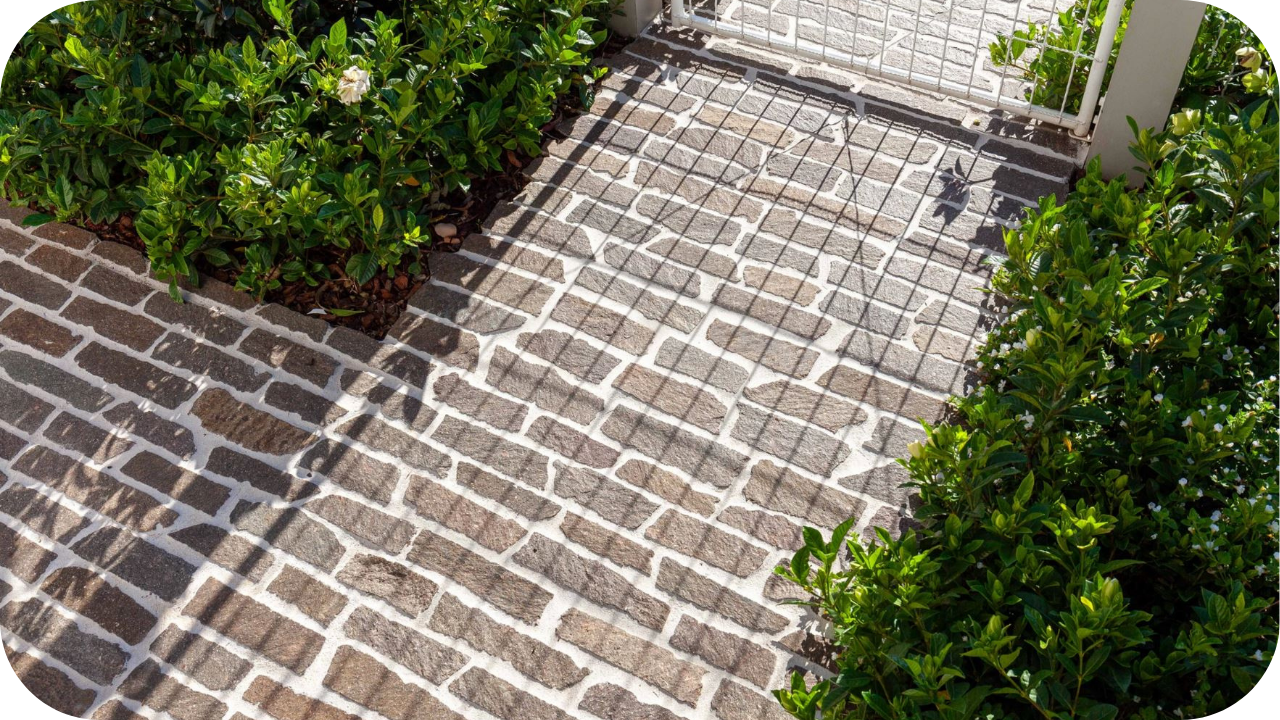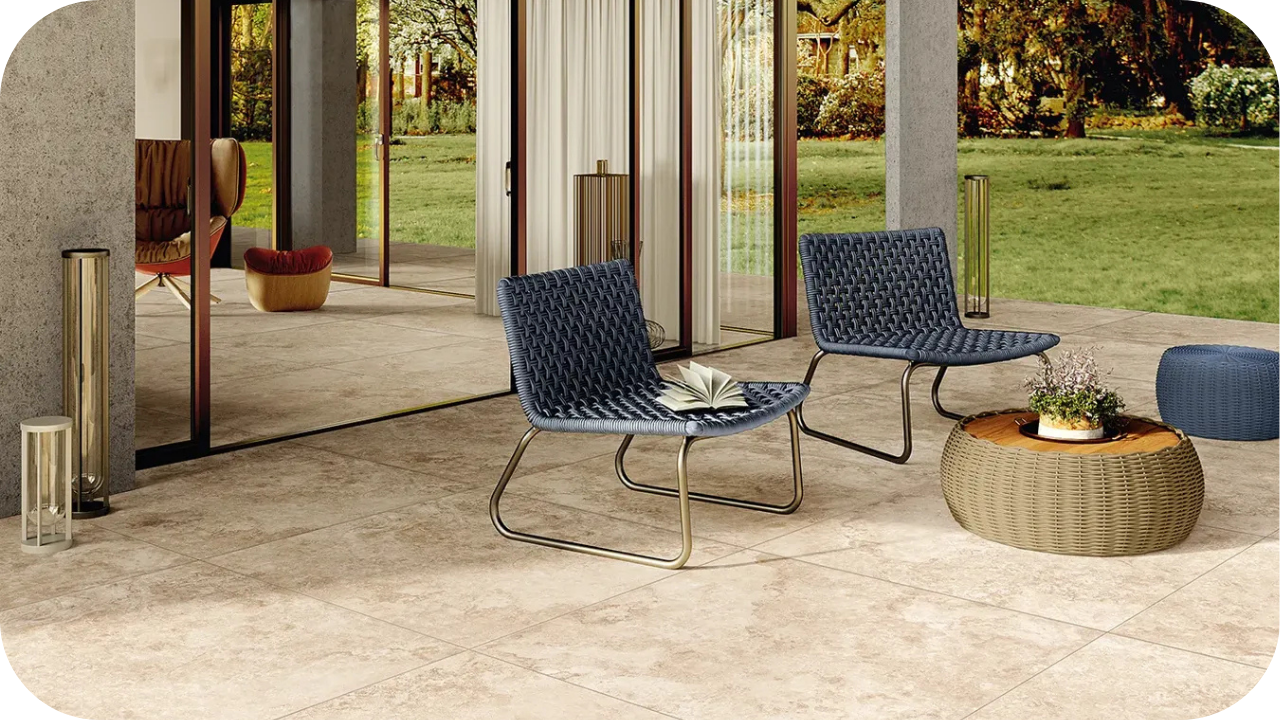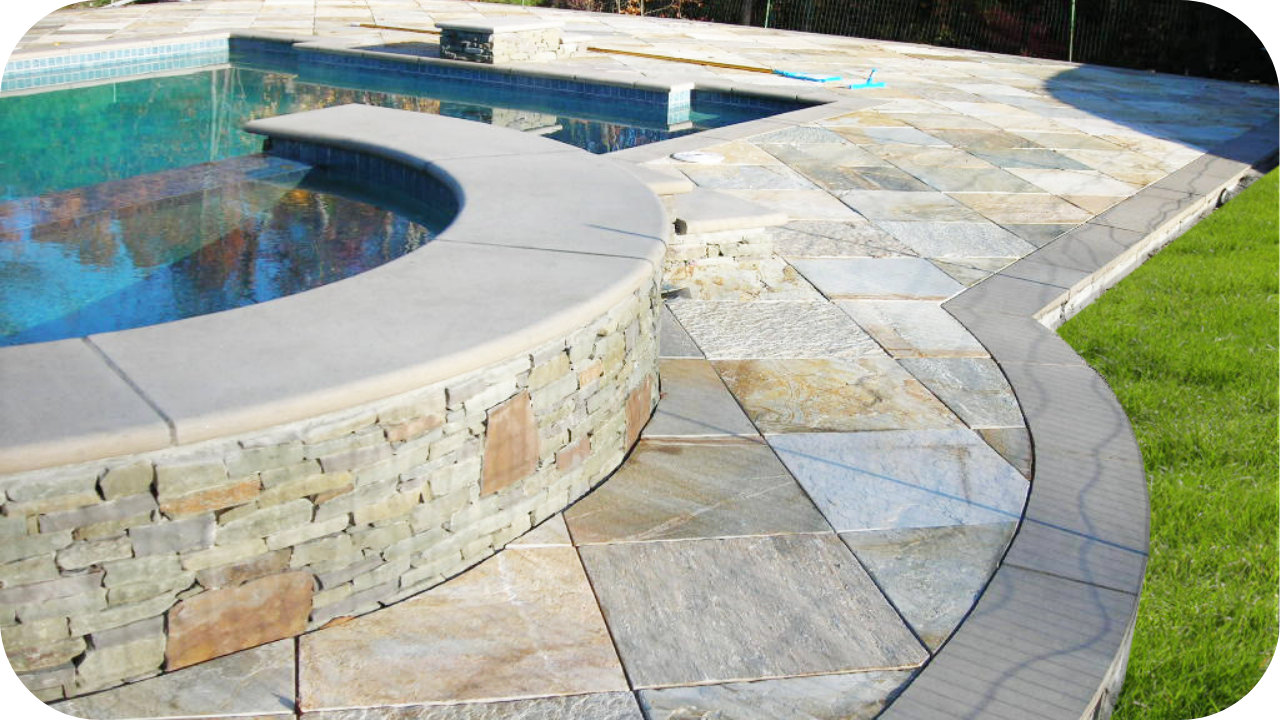
Looking for a paving solution that combines durability with timeless beauty? Porphyry pavers might be exactly what your walkway needs.
Porphyry is a volcanic natural stone known for its incredible strength, textured surface, and rich colour variations. Ideal for creating pathways that withstand heavy use while maintaining their charm, porphyry offers a practical and visually appealing option.
In this article, we will highlight the key benefits of porphyry pavers, design possibilities, important installation considerations, and maintenance tips for building beautiful, long-lasting walkways.
What is Porphyry?
Porphyry is a natural igneous rock formed from slow-cooling magma, resulting in a distinctive crystalline structure set within a fine-grained base. Its surface is naturally textured, making it both visually striking and highly practical for outdoor applications.
Porphyry’s colours range from earthy greys and browns to rich reds and purples, offering plenty of design versatility. Historically used in architecture and grand paving projects across Europe and South America, porphyry is valued for its durability and beauty.
Today, it remains a popular choice for creating walkways that blend seamlessly with gardens, courtyards, and contemporary outdoor spaces.
Why Choose Porphyry for Walkways?

Porphyry is not just visually impressive; it brings a powerful combination of durability, safety, and low maintenance to outdoor spaces. Here is why it stands out for walkways.
1. Exceptional Durability
Porphyry’s dense structure makes it incredibly resistant to wear, heavy foot traffic, and harsh weather. It performs exceptionally well in both residential paths and busy commercial walkways, ensuring long-lasting strength and minimal surface damage.
2. Slip-Resistant Surface
The naturally textured finish of porphyry offers excellent grip, even when wet. This makes it a safer choice for garden paths, pool surrounds, and sloped areas where slip resistance is a top priority.
3. Low Maintenance
Unlike synthetic or concrete pavers, porphyry requires minimal upkeep. It resists moss and mildew build-up with proper drainage, and occasional sweeping and washing easily keep the surface clean and looking its best.
4. Aesthetic Versatility
Porphyry’s natural colour variation and organic texture complement a wide range of landscape designs. Whether creating a traditional garden path or a sleek contemporary walkway, it blends beautifully with timber, gravel, and greenery.
5. Sustainability and Longevity
As a natural material with an exceptionally long lifespan, porphyry reduces the need for frequent replacements. Its durability and low processing impact make it a sustainable, environmentally friendly choice for outdoor projects.
Porphyry vs Other Popular Paving Stones

Choosing the right paving material is crucial for durability, style, and safety. Here’s how porphyry measures up against other popular options side by side.
| Feature | Porphyry | Bluestone | Granite | Concrete Pavers |
| Slip Resistance | Naturally textured, excellent in wet or sloped areas | Good but smoother surfaces may need treatment | Varies by finish, polished granite can be slippery | Textured options available, but can wear smooth over time |
| Colour Variety | Wide range: grey, red, brown, purple | Typically blue-grey tones with limited variation | Grey, black, pink, white, often more uniform | Wide colour options, mostly artificial tones |
| Heat Retention | Stays cool underfoot, even in direct sun | Can heat up noticeably in summer | Warms quickly, retains heat | Can become very hot in direct sun |
| Durability | Extremely durable, handles high traffic and weather extremes | Very durable, strong against wear and weather | Extremely strong but heavier and more brittle | Moderate durability, may crack or shift over time |
| Maintenance Needs | Very low maintenance with proper drainage and occasional cleaning | Requires occasional sealing, prone to staining if neglected | Low maintenance but sealing recommended | Requires more frequent cleaning and repairs |
| Natural Look and Feel | Organic, earthy, and timeless appearance | Natural look, slightly more formal | Sleek and structured appearance | Manufactured look, lacks natural variation |
| Environmental Impact | Low impact, minimal processing, long lifespan | Natural material, moderate processing | Natural material but heavy carbon footprint during quarrying and transport | Higher environmental impact due to manufacturing processes |
| Cost | Mid to high range, justified by longevity and performance | High for premium grades | High, especially for premium finishes | Lower initial cost but higher maintenance over time |
Common Applications of Porphyry Pavers

Porphyry’s strength, slip resistance, and natural beauty make it a top choice for a wide variety of outdoor applications. Here are the most popular and practical ways to use it.
1. Garden Paths
Porphyry’s textured surface and earthy tones create inviting, durable garden paths. Its slip resistance makes it perfect for shaded or moisture-prone areas where safety and natural aesthetics are both important considerations.
2. Driveways
Porphyry’s exceptional load-bearing capacity allows it to handle vehicle traffic without cracking or shifting. It brings rustic charm or modern elegance to driveways while standing up to daily use and harsh weather.
3. Public Spaces and Laneways
Porphyry is ideal for high-traffic public areas like city squares, laneways, and plazas. Its ability to withstand constant foot traffic and minimal maintenance needs makes it a favourite for urban landscaping projects.
4. Pool Surrounds
The slip-resistant texture of porphyry makes it ideal for both pool surrounds and pool coping. It stays cool underfoot, even in direct sunlight, and can withstand exposure to water, chlorine, and UV rays without losing its natural charm.
5. Stepping Stones
Porphyry pavers can be used individually as stepping stones, offering a casual, organic feel to garden pathways. Their natural strength ensures stability, while their rugged surface enhances safety underfoot.
6. Outdoor Staircases
Thanks to its durability and traction, porphyry is an excellent choice for outdoor steps and staircases. Its textured finish reduces the risk of slipping, providing both functional and aesthetic value.
7. Entryways and Thresholds
Porphyry adds a sense of grandeur and permanence to entryways and thresholds. Its rich, earthy hues create a welcoming, durable entrance that withstands heavy use and enhances curb appeal.
Design Options and Layout Ideas

Porphyry’s versatility allows for a wide range of creative designs. Here are some of the most effective and visually striking ways to use it in outdoor spaces.
1. Cobblestone Format
Cobblestone porphyry pavers offer old-world charm with a timeless feel. Ideal for driveways, laneways, and historic gardens, they create durable, flexible surfaces that move naturally with ground settling and temperature changes.
2. Random Crazy Paving
Random-shaped porphyry pieces laid in crazy paving patterns create organic, informal walkways and patios. This style enhances rustic gardens and Mediterranean-inspired spaces with natural, flowing movement across outdoor areas.
3. Rectangular and Modular Patterns
Rectangular and square-cut porphyry pavers suit formal designs beautifully. Neat modular patterns lend order and symmetry to courtyards, pathways, and terraces, balancing porphyry’s natural variations with strong geometric structure.
4. Fan Layouts
Fan or arc patterns using small-format porphyry stones add dynamic movement to wide paths, plazas, and courtyards. This classic European style brings sophistication and intricate visual interest to outdoor flooring.
5. Staggered Jointing
Using staggered joints with rectangular stones softens rigid layouts and introduces subtle texture. This technique is ideal for contemporary spaces that desire natural variation without compromising the overall sense of order.
6. Mixed Size Combinations
Combining different stone sizes creates a more relaxed, hand-crafted look. This technique enhances traditional gardens, alfresco areas, and informal courtyards by avoiding repetition and introducing organic flow underfoot.
7. Pairing with Timber, Steel, or Gravel
Blending porphyry with timber decking, steel borders, or decorative gravel delivers a striking textural contrast. This approach suits modern and rustic landscapes alike, offering variety without losing cohesion or durability.
Installation Considerations

Proper installation is crucial to maximise the durability and visual impact of porphyry pavers. Here are the most important factors to consider before and during your project.
- Prepare a solid base layer: A well-compacted crushed rock or concrete base prevents movement and ensures long-term stability. Poor base preparation can lead to shifting, cracking, and uneven surfaces over time, especially under heavy loads.
- Allow for adequate drainage: Proper slope and drainage prevent water pooling under or around pavers. Standing water can weaken the base and encourage moss growth, reducing both the lifespan and appearance of the walkway.
- Choose the right jointing material: For areas with light traffic, sand jointing can suffice. For driveways or heavy-use paths, mortar jointing is recommended to lock the stones in place and resist movement from weight and weather.
- Account for expansion and contraction: Natural stones expand and contract slightly with temperature changes. Leaving small expansion gaps in wider installations helps maintain the integrity of the surface without creating pressure points or cracks.
- Hire an experienced installer: Porphyry’s irregular shapes and variations require skill to fit attractively and securely. A professional installer ensures clean layouts, strong foundations, and optimal performance over the life of the walkway.
Maintenance Tips

Keeping your porphyry walkway looking its best is simple with a few regular practices. Here are easy maintenance tips to protect its beauty and extend its lifespan.
- Sweep regularly to remove debris: Dirt, leaves, and small stones can scratch or stain the surface over time. A simple weekly sweep helps prevent buildup and keeps your walkway clean and welcoming throughout the seasons.
- Rinse with water when needed: Occasional rinsing with a garden hose removes dust, light stains, and organic material. Avoid high-pressure hoses that might dislodge jointing sand or damage surface finishes, especially in aged installations.
- Seal if necessary to enhance longevity: Porphyry usually performs well without sealing, but sealing can enhance colour richness and provide extra protection in areas exposed to heavy water runoff, salt, or potential staining agents.
- Address moss and mildew early: In shaded or damp areas, moss and mildew may form. Treat them early with pH-neutral cleaners or a gentle moss remover to avoid slippery surfaces and maintain your walkway’s appearance.
- Replace damaged or shifted stones promptly: One of porphyry’s advantages is that individual pavers can be replaced without disturbing the entire surface. Address cracked or loose stones quickly to maintain safety and surface integrity.
Conclusion
Porphyry pavers offer a rare combination of strength, slip resistance, low maintenance, and timeless style, making them a superior choice for any walkway project. Their natural beauty and durability ensure a long-lasting investment that enhances outdoor spaces for years to come.
If you are ready to create elegant, high-performance walkways, speak to the experts at Splendour in Stone today. We will help you find the perfect porphyry solutions tailored to your landscape vision.
More To Explore

Is Travertine Ideal for Patio Flooring?
Looking for a natural stone that is both stylish and practical for your outdoor space? Travertine might just be the answer. Travertine is one of

Is Quartzite the Best Choice for Pool Coping
Choosing the right coping material for your pool is about more than just style: it is about performance, safety, and long-term durability. Coping protects the


